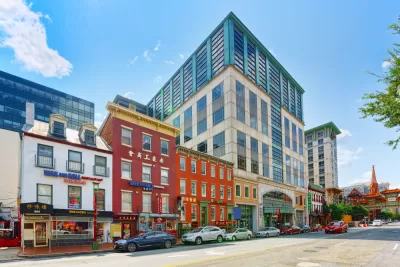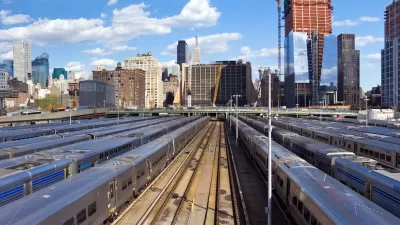A series of articles traces the history and policies behind Washington, D.C.’s efforts to promote equitable transit-oriented development.

In one part of a Greater Greater Washington series that explores the history of transit-oriented development (TOD) in the Washington, D.C. region, George Kevin Jordan outlines the ways that TOD can perpetuate existing inequities. “Today, with unaffordability and displacement in many cities at a crisis level, policymakers and activists are wondering how to ensure the benefits of TOD are more equitably distributed.”
Jordan points to changes that occurred under the administration of Mayor Anthony Williams, who took office in 1999 and “was laser-focused on bringing the city back to its former glory by building back trust, stability, and reliability within government.” As part of his plan, Williams strove to bring real estate investors back to the District and build better transit. “The District’s transformation into an in-demand city had ripple effects on many different types of growth in the region, including transit-oriented development.”
As walkable, transit-oriented neighborhoods became more desirable, housing costs rose and older residents were pushed out. “Between 2000 and 2013, about 40 percent of the city’s lower-income neighborhoods experienced gentrification, according to a 2019 study by the National Community Reinvestment Coalition.” The same report claims that more than 20,000 Black residents were displaced during that time. “Meanwhile, not only were residents living East of the Anacostia River not seeing much TOD, they were also dealing with disproportionate social and economic issues,” creating “an uneven set of opportunities for families and businesses.”
The next article in the series will highlight Arlington, “one of the pioneers in TOD, and how its success has complicated and informed the work to achieve equitable transit-oriented development.”
FULL STORY: Understanding why the region grapples with unequal access to TOD

Maui's Vacation Rental Debate Turns Ugly
Verbal attacks, misinformation campaigns and fistfights plague a high-stakes debate to convert thousands of vacation rentals into long-term housing.

Planetizen Federal Action Tracker
A weekly monitor of how Trump’s orders and actions are impacting planners and planning in America.

San Francisco Suspends Traffic Calming Amidst Record Deaths
Citing “a challenging fiscal landscape,” the city will cease the program on the heels of 42 traffic deaths, including 24 pedestrians.

Adaptive Reuse Will Create Housing in a Suburban Texas Strip Mall
A developer is reimagining a strip mall property as a mixed-use complex with housing and retail.

Study: Anti-Homelessness Laws Don’t Work
Research shows that punitive measures that criminalized unhoused people don’t help reduce homelessness.

In U.S., Urban Gondolas Face Uphill Battle
Cities in Latin America and Europe have embraced aerial transitways — AKA gondolas — as sustainable, convenient urban transport, especially in tricky geographies. American cities have yet to catch up.
Urban Design for Planners 1: Software Tools
This six-course series explores essential urban design concepts using open source software and equips planners with the tools they need to participate fully in the urban design process.
Planning for Universal Design
Learn the tools for implementing Universal Design in planning regulations.
Heyer Gruel & Associates PA
JM Goldson LLC
Custer County Colorado
City of Camden Redevelopment Agency
City of Astoria
Transportation Research & Education Center (TREC) at Portland State University
Jefferson Parish Government
Camden Redevelopment Agency
City of Claremont





























